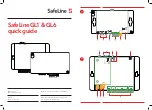
Chapter 17 VoIP
LTE-5121 User’s Guide
184
Type of Service (ToS)
Network traffic can be classified by setting the ToS (Type of Service) values at the data source (for
example, at the LTE Device) so a server can decide the best method of delivery, that is the least
cost, fastest route and so on.
DiffServ
DiffServ is a class of service (CoS) model that marks packets so that they receive specific per-hop
treatment at DiffServ-compliant network devices along the route based on the application types
and traffic flow. Packets are marked with DiffServ Code Points (DSCP) indicating the level of service
desired. This allows the intermediary DiffServ-compliant network devices to handle the packets
differently depending on the code points without the need to negotiate paths or remember state
information for every flow. In addition, applications do not have to request a particular service or
give advanced notice of where the traffic is going.
3
DSCP and Per-Hop Behavior
DiffServ defines a new DS (Differentiated Services) field to replace the Type of Service (TOS) field
in the IP header. The DS field contains a 2-bit unused field and a 6-bit DSCP field which can define
up to 64 service levels. The following figure illustrates the DS field.
DSCP is backward compatible with the three precedence bits in the ToS octet so that non-DiffServ
compliant, ToS-enabled network device will not conflict with the DSCP mapping.
Figure 121
DiffServ: Differentiated Service Field
The DSCP value determines the forwarding behavior, the PHB (Per-Hop Behavior), that each packet
gets across the DiffServ network. Based on the marking rule, different kinds of traffic can be
marked for different priorities of forwarding. Resources can then be allocated according to the DSCP
values and the configured policies.
17.8.4 Phone Services Overview
Supplementary services such as call hold, call waiting, and call transfer. are generally available from
your VoIP service provider. The LTE Device supports the following services:
• Call Hold
• Call Waiting
• Making a Second Call
• Call Transfer
• Three-Way Conference
• Internal Calls
3.
The LTE Device does not support DiffServ at the time of writing.
DSCP
(6-bit)
Unused
(2-bit)
Содержание LTE5121
Страница 4: ...Contents Overview LTE 5121 User s Guide 4...
Страница 12: ...Table of Contents LTE 5121 User s Guide 12...
Страница 13: ...13 PART I User s Guide...
Страница 14: ...14...
Страница 22: ...Chapter 1 Introduction LTE 5121 User s Guide 22...
Страница 28: ...28...
Страница 42: ...Chapter 4 Broadband LTE 5121 User s Guide 42...
Страница 70: ...Chapter 5 Wireless LTE 5121 User s Guide 70...
Страница 98: ...Chapter 7 Static Route LTE 5121 User s Guide 98...
Страница 102: ...Chapter 8 DNS Route LTE 5121 User s Guide 102...
Страница 114: ...Chapter 9 Quality of Service QoS LTE 5121 User s Guide 114...
Страница 138: ...Chapter 14 Parental Control LTE 5121 User s Guide 138...
Страница 148: ...Chapter 15 Certificates LTE 5121 User s Guide 148...
Страница 151: ...Chapter 16 VPN LTE 5121 User s Guide 151 Figure 104 IPSec VPN Add...
Страница 162: ...Chapter 16 VPN LTE 5121 User s Guide 162...
Страница 198: ...Chapter 19 User Account LTE 5121 User s Guide 198...
Страница 214: ...Chapter 26 Backup Restore LTE 5121 User s Guide 214...
Страница 224: ...Chapter 28 Troubleshooting LTE 5121 User s Guide 224...
Страница 234: ...Index LTE 5121 User s Guide 234...
















































